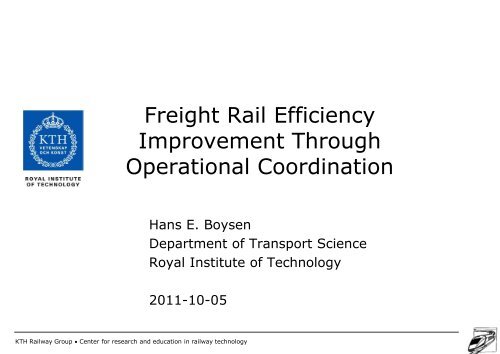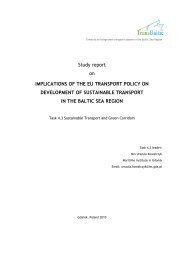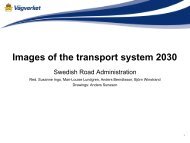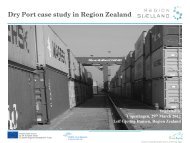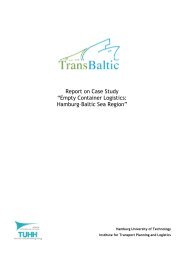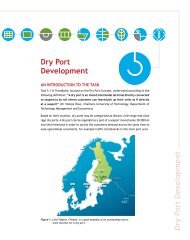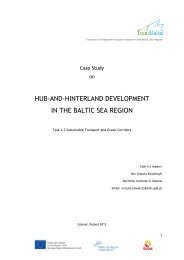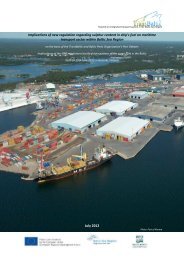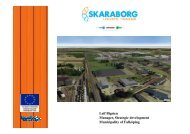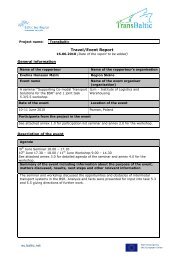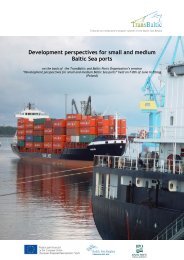Freight Rail Efficiency Improvement Through ... - TransBaltic
Freight Rail Efficiency Improvement Through ... - TransBaltic
Freight Rail Efficiency Improvement Through ... - TransBaltic
You also want an ePaper? Increase the reach of your titles
YUMPU automatically turns print PDFs into web optimized ePapers that Google loves.
<strong>Freight</strong> <strong>Rail</strong> <strong>Efficiency</strong><br />
<strong>Improvement</strong> <strong>Through</strong><br />
Operational Coordination<br />
Hans E. Boysen<br />
Department of Transport Science<br />
Royal Institute of Technology<br />
2011-10-05<br />
KTH <strong>Rail</strong>way Group Center for research and education in railway technology
Main Topics<br />
• Traffic trends<br />
• Capacity bottlenecks<br />
• Infrastructure improvement plans<br />
• Limiting technical standards<br />
• Recommended best practice<br />
KTH <strong>Rail</strong>way Group Center for research and education in railway technology
Shippers’ Priorities<br />
Elasticity of demand indexed by cost<br />
1,2<br />
1<br />
0,8<br />
0,6<br />
0,4<br />
0,2<br />
Elasticity of demand<br />
0<br />
2007<br />
KTH <strong>Rail</strong>way Group Center for research and education in railway technology
Swedish Cross-border <strong>Rail</strong> <strong>Freight</strong><br />
Tonnage excluding iron ore (1000 tons)<br />
10000<br />
9000<br />
8000<br />
7000<br />
20092010<br />
rail freight:<br />
Domestic +15 %<br />
ØSB +34 %<br />
6000<br />
5000<br />
4000<br />
3000<br />
Intermodal<br />
Wagonload/Unit<br />
train<br />
2000<br />
1000<br />
0<br />
2004 2005 2006 2007 2008 2009 2010<br />
KTH <strong>Rail</strong>way Group Center for research and education in railway technology
Direct <strong>Rail</strong> <strong>Freight</strong> Relations 2011<br />
o/w = one way<br />
r/t = round trip<br />
• Intermodal trains<br />
Oslo A–ØSB–Rotterdam RSC r/t 2/wk Bring Frigo<br />
Katrineholm–ØSB–Herne WW r/t 5/wk van Dieren Maritime<br />
Nässjö–ØSB–Herne WW r/t 3/wk van Dieren Maritime<br />
Göteborg G–ØSB–Herne WW r/t 5/wk van Dieren Maritime<br />
Helsingborg–ØSB–Herne WW r/t 4/wk van Dieren Maritime/KV<br />
Malmö–ØSB–Taulov r/t 7/wk Hupac<br />
Malmö–ØSB–Hannover Leinetor r/t 6/wk LKW Walter<br />
Malmö–ØSB–Herne WW r/t 6/wk TX Logistik<br />
Malmö–ØSB–Krefeld r/t 6/wk LKW Walter<br />
Taulov–Hamburg Billwerder r/t 3/wk Kombiverkehr<br />
Taulov–Busto Arsizio G r/t 10/wk Hupac<br />
Taulov–Verona QE r/t 5/wk Hupac<br />
Padborg–Hall–Verona QE r/t 2/wk TX Logistik<br />
Padborg–Verona QE r/t (direct) 2/wk TX Logistik<br />
KTH <strong>Rail</strong>way Group Center for research and education in railway technology
Direct <strong>Rail</strong> <strong>Freight</strong> Relations 2011<br />
o/w = one way<br />
r/t = round trip<br />
• Wagonload trains<br />
Borlänge–TS–Seddin o/w 6/wk Green Cargo<br />
Malmö–ØSB–Fredericia r/t 5/wk Green Cargo<br />
Malmö–ØSB–Maschen r/t<br />
27/wk Green Cargo<br />
Malmö–TS–Seddin o/w 5/wk Green Cargo<br />
Trelleborg–TR–Domodossola r/t 1/wk Nordisk Transport <strong>Rail</strong><br />
Trelleborg–TR–Treviso r/t 2/wk Nordisk Transport <strong>Rail</strong><br />
Maschen–ST–Malmö o/w 3/wk Green Cargo<br />
Seddin–ST–Malmö o/w<br />
12/wk Green Cargo<br />
• Unit trains<br />
Älmhult–ØSB–Gent Z r/t<br />
12/wk Volvo<br />
Göteborg A–ØSB–Hannover Lin. r/t 5/wk Volvo<br />
Malmö–ØSB–Maschen r/t<br />
12/wk Scandfibre Logistics<br />
Malmö–ØSB–Dortmund O/S r/t 19/wk Scandfibre Logistics<br />
KTH <strong>Rail</strong>way Group Center for research and education in railway technology
<strong>Rail</strong> <strong>Freight</strong> Corridors<br />
2011<br />
Narvik<br />
Scandria corridor<br />
<strong>Rail</strong> ferry link<br />
Marshalling yard<br />
Luleå<br />
Skellefteå<br />
Oulu<br />
Trondheim<br />
Östersund<br />
Örnsköldsvik<br />
Umeå<br />
<strong>Rail</strong> <strong>Freight</strong><br />
Corridors<br />
2011<br />
Bergen<br />
Stavanger<br />
Taulov<br />
Drammen<br />
Århus<br />
Oslo<br />
Göteborg<br />
Odense<br />
Trollhättan<br />
Ålborg<br />
Halmstad<br />
Helsing -<br />
borg<br />
Køben -<br />
havn<br />
Skövde<br />
Varberg<br />
Jönköping<br />
Sundsvall<br />
Falun<br />
Gävle<br />
Borlänge<br />
Uppsala<br />
Västerås<br />
Örebro<br />
Hallsberg<br />
Ånge<br />
Nässjö<br />
Älmhult<br />
Lund<br />
Malmö<br />
Trelleborg<br />
Katrineholm<br />
Norrköping<br />
Linköping<br />
Tampere<br />
Turku<br />
Stockholm<br />
Kouvola<br />
S:t Petersburg<br />
Helsinki<br />
Tallinn<br />
Riga<br />
Hamburg<br />
Rostock<br />
Sassnitz<br />
Berlin<br />
KTH <strong>Rail</strong>way Group Center for research and education in railway technology
<strong>Rail</strong> <strong>Freight</strong> Corridors in 2011<br />
<strong>Freight</strong> train paths/day<br />
in each direction:<br />
Via Taulov 48<br />
Via Rostock 3 (large)<br />
Via Sassnitz 4<br />
KTH <strong>Rail</strong>way Group Center for research and education in railway technology
Germany: Capacity Bottlenecks in 2006<br />
<br />
Map:<br />
BMVBS<br />
KTH <strong>Rail</strong>way Group Center for research and education in railway technology
Germany: Capacity Expansions<br />
Rendsburg<br />
22.5 t/axle, 8 t/m 2013<br />
Ahrensburg-<br />
Hamburg TT<br />
Hamburg<br />
shorter blocks<br />
Stelle-Lüneburg<br />
TT 2015<br />
E = electrification<br />
DT = double track<br />
TT = triple track<br />
Puttgarden-<br />
(Fehmarnsund)-<br />
Bad Schwartau<br />
E 2020, DT 2027<br />
Rostock-Berlin<br />
25 t/axle 2013<br />
Uelzen-Stendal<br />
DT ≈2017<br />
Hof-<br />
Reichenbach<br />
E 2013<br />
Reichenbach-<br />
Marktredwitz-<br />
Regensburg<br />
E ≈2019<br />
Map: DB Netze<br />
KTH <strong>Rail</strong>way Group Center for research and education in railway technology
Denmark: Capacity Expansions<br />
Ringsted-Køge-København<br />
new line, DT+E 2018<br />
Vamdrup-<br />
Vojens<br />
DT 2015<br />
DT = double track<br />
E = electrification<br />
Fehmarnbelt<br />
new line, DT+E 2020<br />
Rødby-Storstrøm<br />
DT+E 2020<br />
Ringsted-<br />
Storstrøm<br />
E 2020<br />
Map: TM<br />
KTH <strong>Rail</strong>way Group Center for research and education in railway technology
Sweden: Capacity Bottlenecks in 2011<br />
and Expansions<br />
Kilafors-Söderhamn<br />
U, CTC, siding 2016<br />
Västeraspby-Härnösand<br />
U, sidings 2012-08-01<br />
Sundsvall-Gävle<br />
sidings 2011-2014, ≈2021<br />
Kilafors-Holmsveden<br />
siding ≈2021<br />
Trollhättan-Göteborg<br />
DT 2012<br />
Varberg<br />
DT ≈2021<br />
Hallandsåsen<br />
DT, tunnel 2015<br />
Stockholm<br />
QT 2017<br />
Hallsberg-Degerön<br />
siding ≈2013<br />
Motala-Fågelsta<br />
DT 2012<br />
Flackarp-Arlöv<br />
QT 2018<br />
DT = double track<br />
QT = quadruple track<br />
U = upgrade<br />
KTH <strong>Rail</strong>way Group Center for research and education in railway technology<br />
Malmö-Trelleborg<br />
U, siding 2015<br />
Map: TRV
<strong>Rail</strong> <strong>Freight</strong> Corridors<br />
2020<br />
Narvik<br />
Scandria corridor<br />
<strong>Rail</strong> ferry link<br />
Marshalling yard<br />
Luleå<br />
Skellefteå<br />
Oulu<br />
Trondheim<br />
Östersund<br />
Vännäs<br />
Örnsköldsvik<br />
Umeå<br />
<strong>Rail</strong> <strong>Freight</strong><br />
Corridors<br />
2020<br />
Bergen<br />
Stavanger<br />
Taulov<br />
Drammen<br />
Århus<br />
Oslo<br />
Göteborg<br />
Odense<br />
Trollhättan<br />
Ålborg<br />
Halmstad<br />
Helsing -<br />
borg<br />
Køben -<br />
havn<br />
Skövde<br />
Varberg<br />
Jönköping<br />
Sundsvall<br />
Falun<br />
Gävle<br />
Borlänge<br />
Uppsala<br />
Västerås<br />
Örebro<br />
Hallsberg<br />
Ånge<br />
Nässjö<br />
Älmhult<br />
Lund<br />
Malmö<br />
Trelleborg<br />
Katrineholm<br />
Norrköping<br />
Linköping<br />
Tampere<br />
Turku<br />
Stockholm<br />
Riihimäki<br />
S:t Petersburg<br />
Helsinki<br />
Tallinn<br />
Kouvola<br />
Riga<br />
Hamburg<br />
Rostock<br />
Sassnitz<br />
Berlin<br />
KTH <strong>Rail</strong>way Group Center for research and education in railway technology
<strong>Rail</strong> <strong>Freight</strong> Corridors from 2020<br />
<strong>Freight</strong> train paths/day<br />
in each direction:<br />
Via Taulov 48<br />
Via Fehmarnbelt also 48<br />
Possible improvements:<br />
Shortest routes,<br />
electrification needed<br />
• Lübeck-Lüneburg<br />
• Lübeck-Bad Kleinen<br />
Connection needed<br />
• Bad Kleinen<br />
KTH <strong>Rail</strong>way Group Center for research and education in railway technology
<strong>Rail</strong> <strong>Freight</strong> Policy<br />
EU 2011:<br />
• Transfer 30 % of road freight to rail and sea by 2030,<br />
• and transfer 50 % by 2050.<br />
KTH <strong>Rail</strong>way Group Center for research and education in railway technology
Operational Goals<br />
High<br />
efficiency<br />
High-density<br />
commodity<br />
Low-density<br />
commodity<br />
Train length<br />
limited<br />
High train<br />
mass<br />
High meter<br />
load<br />
High train<br />
volume<br />
Train length<br />
limited<br />
Large useful<br />
cross section<br />
KTH <strong>Rail</strong>way Group Center for research and education in railway technology
Today’s Actual Meter Loads<br />
• Common commodities<br />
- intermodal trains: 2.0 to 2.5 tons/m<br />
- paper in Habbins wagons: 3.9 tons/m<br />
KTH <strong>Rail</strong>way Group Center for research and education in railway technology
<strong>Rail</strong> <strong>Freight</strong> Costs (Flodén 2011)<br />
Medium-cost scenario<br />
High-cost scenario<br />
Overhead<br />
Crew<br />
Locomotive<br />
Terminals<br />
Infrastructure<br />
Electricity<br />
Wagons<br />
• Independent of train size: overhead, crew<br />
• Incremental: locomotive(s)<br />
• Less than proportional to train size: terminals, infrastructure<br />
• Approx. proportional to train size: electricity, wagons<br />
Large trains, utilizing each locomotive fully, minimize cost per load unit.<br />
KTH <strong>Rail</strong>way Group Center for research and education in railway technology
Train Tonnage Limitations<br />
• Ratings for modern locomotive (84 tons, 5600 kW)<br />
- on 10 to 12.5 ‰ gradient: ≈ 2400 – 2600 tons<br />
- on 16.5 ‰ gradient: 1600 – 1700 tons (Storebælt)<br />
KTH <strong>Rail</strong>way Group Center for research and education in railway technology
Sample Operating Scenarios<br />
Assumptions (medium term): Train lengths, gradients, locomotives given.<br />
Corresponding meter load<br />
1 loco 2 locos<br />
Gradient 17 ‰ 10 – 12 ‰ 17 ‰ 10 – 12 ‰<br />
Tonnage rating 1700 tons 2500 tons 3400 tons 5000 tons<br />
Train length 700 m 2.4 tons/m 3.6 tons/m 4.9 tons/m<br />
Train length 800 m 2.1 tons/m 3.1 tons/m 4.2 tons/m<br />
7.1 tons/m<br />
6.2 tons/m<br />
To achieve high system utilization<br />
Intermodal trains: 1 locomotive, (2–2.5)≈3 tons/m<br />
Paper trains: 2 locomotives, (3.9)≈6 tons/m<br />
… but how?<br />
KTH <strong>Rail</strong>way Group Center for research and education in railway technology
Long Tracks of <strong>Rail</strong>way <strong>Freight</strong> Yards<br />
Vns 645 m (669 m)<br />
Suc 684 m<br />
Alb 665 m<br />
Åggb 796 m<br />
Blg 710 m (869 m)<br />
Gäb 773 m<br />
Vka 966 m<br />
Kvla 1008 m<br />
Drm 697 m<br />
Hrbg 890 m<br />
Nr 636 m<br />
Sär 753 m (855 m)<br />
Wrss 755 m (1030 m)<br />
Am 805 m (1013 m)<br />
Mgb 877 m<br />
Trg 705 m<br />
Wm 800 m<br />
Note: Track<br />
lengths shown<br />
are electrified<br />
receiving or<br />
departure<br />
tracks (others).<br />
Hsr 809 m (876 m) Bse 755 m (835 m)<br />
Map: KTH<br />
KTH <strong>Rail</strong>way Group Center for research and education in railway technology
Present Corridor Standards<br />
Train length w.r.t. brakes, ferry track length (m)<br />
1200<br />
1000<br />
800<br />
600<br />
400<br />
200<br />
0<br />
Train length (m)<br />
Ferry track length (m)<br />
Column1<br />
Development: Train length Padborg-Hamburg 835 m planned for 2011.<br />
KTH <strong>Rail</strong>way Group Center for research and education in railway technology
Present Corridor Standards<br />
<strong>Freight</strong> train speed vs. length (Denmark)<br />
Speed (km/h)<br />
Train length (m)<br />
100 835<br />
120 600<br />
Limited by braking performance and signal distance.<br />
KTH <strong>Rail</strong>way Group Center for research and education in railway technology
Distance<br />
The Role of Speed<br />
Mixed traffic consumes available capacity …<br />
Time<br />
Time<br />
… while homogenous traffic at uniform speed can run at high frequency.<br />
KTH <strong>Rail</strong>way Group Center for research and education in railway technology
Speed vs. Load Rating of Wagons<br />
ABCDE markings, example (Shimmnss)<br />
A B C D E<br />
S 38,7 t 50,5 t 60,5 t 68,5 t 78,5 t<br />
SS 38,7 t 50,5 t 58,5 t<br />
Legend<br />
Track axle load limit: A=16 t, B=18 t, C=20 t, D=22.5 t, E=25 t<br />
Wagon speed limit: S=100 km/h, SS=120 km/h<br />
Wagon load limit: t<br />
KTH <strong>Rail</strong>way Group Center for research and education in railway technology
Present Corridor Standards<br />
Train wagon mass limit (tons)<br />
4500<br />
4000<br />
3500<br />
3000<br />
2500<br />
2000<br />
1500<br />
1000<br />
500<br />
0<br />
Train wagon mass<br />
limit (tons)<br />
Note: Limits for screw couplers. Higher values for automatic couplers.<br />
Tractive effort of 0.60 MN corresponds to ≈5200 tons on 10 ‰.<br />
KTH <strong>Rail</strong>way Group Center for research and education in railway technology
Vehicle Height Limits on the Highway<br />
Vision: P/C 450<br />
rail corridor<br />
>4.5 m<br />
4.2 m<br />
4.65 m<br />
>4.95 m<br />
4.0 m<br />
>4.5 m<br />
4.1 m<br />
KTH <strong>Rail</strong>way Group Center for research and education in railway technology
<strong>Rail</strong>way Intermodal Gauges<br />
Interunit 2009<br />
(modified)<br />
Fran-Scan<br />
Hi-cube<br />
Intermodal<br />
Corridor G2,<br />
P/C 450<br />
(proposed)<br />
P450<br />
P432<br />
P422<br />
P410<br />
P400<br />
P380<br />
P359<br />
No code
UIC Intermodal Gauge P/C 450<br />
C=container<br />
P=pocket<br />
KTH <strong>Rail</strong>way Group Center for research and education in railway technology
Alternative Use of P/C 450: Ro-Ro<br />
Trailer Train
Other Loads: House Sections and Lumber<br />
Bengt Dahlberg<br />
Felix Hubertsson<br />
1268 mm floor height, Rs<br />
1336 mm riser height, Kbps
Forest Products in Gauge P/C 450<br />
Section width<br />
255 cm<br />
Overhead contact wire<br />
Load width<br />
210 cm<br />
Packaged<br />
lumber<br />
Packaged<br />
lumber<br />
Maximum<br />
section height<br />
356 cm<br />
Maximum<br />
total height<br />
483 cm ATOR<br />
House<br />
section<br />
Package<br />
110 cm<br />
Spacer<br />
4 cm<br />
Packaged<br />
lumber<br />
Packaged<br />
lumber<br />
Packaged<br />
lumber<br />
Packaged<br />
lumber<br />
Maximum<br />
load height<br />
347 cm<br />
Wagon floor height<br />
127 cm ATOR<br />
Wagon<br />
Top of rail<br />
Wagon<br />
Wagon riser height<br />
136 cm ATOR<br />
ATOR = above top of rail<br />
Lumber can be stacked 1 package higher (+50%)<br />
in intermodal gauge P/C 450 than in P/C 400.<br />
KTH <strong>Rail</strong>way Group Center for research and education in railway technology
Vertical Clearance Requirements<br />
• OHL construction tolerance:<br />
• Contact line dynamic movement:<br />
30 mm<br />
50 mm<br />
• Electrical minimum clearance (EBO, VDE 0115-1):<br />
- 25 kV 220 mm<br />
- 15 kV 150 mm<br />
- 3 kV 50 mm<br />
- 1.5 kV 35 mm<br />
• Vehicle dynamic movement (TSI):<br />
• Track ballast tamping allowance:<br />
50 mm<br />
50 mm<br />
Total clearance 215 mm to 400 mm needed to OHL.<br />
(Normal OHL height: 5.3 – 5.5 m ATOR)
<strong>Rail</strong>way Loading Gauges<br />
Vision: G2<br />
rail corridor<br />
G2<br />
>G2<br />
Present Corridor Standards<br />
Loading gauges and intermodal gauges<br />
Finland<br />
KU<br />
P/C 497<br />
Norway<br />
M, U<br />
P/C 410<br />
Sweden<br />
A, C<br />
P/C 450<br />
P/C 432<br />
P/C 422<br />
P/C 410<br />
Øresund<br />
UIC GC<br />
P/C 450<br />
Denmark<br />
Germany<br />
G2<br />
P/C 410<br />
P/C 405<br />
P/C 400<br />
KTH <strong>Rail</strong>way Group Center for research and education in railway technology
Present Corridor Standards<br />
Loading gauge or intermodal gauge useful cross section (m 2 )<br />
14<br />
12<br />
10<br />
8<br />
6<br />
4<br />
2<br />
Useful cross section<br />
(m2)<br />
0<br />
Desired gauges<br />
Note: Largest inscribed rectangular section above floor height 1.2 m<br />
or above container mounts 1.175 m ATOR.<br />
KTH <strong>Rail</strong>way Group Center for research and education in railway technology
Desired Loading and Intermodal Gauges<br />
OHL 5.30 m<br />
Clearance ≥ 0.40 m (25 kV)<br />
Wide<br />
3.60 m 4.90 m<br />
P/C 450<br />
2.60 m 4.83 m<br />
Medium<br />
3.40 m 4.90 m<br />
P/C 400<br />
2.60 m 4.33 m<br />
Narrow<br />
3.15 m 4.90 m<br />
TOR 0.00 m<br />
Pocket 0.33 m<br />
KTH <strong>Rail</strong>way Group Center for research and education in railway technology
Opportunities of a Large Gauge<br />
Kockums Industrier<br />
Kockums Industrier<br />
133 m 3 volume, Hiqqrrs-vw wagon 148 m 3 volume, SECU container<br />
KTH <strong>Rail</strong>way Group Center for research and education in railway technology
Opportunities of a Large Gauge<br />
Frederik Tellerup<br />
Michael Nilsson<br />
5 seats across, X53 unit 3.45 m width, X55 unit<br />
KTH <strong>Rail</strong>way Group Center for research and education in railway technology
Opportunities of a Large Gauge<br />
Robert Schwandl<br />
Robert Schwandl<br />
6 seats across, SA unit 3.60 m width, SA unit<br />
KTH <strong>Rail</strong>way Group Center for research and education in railway technology
Present Corridor Standards<br />
Meter load (tons/m)<br />
12<br />
10<br />
8<br />
6<br />
4<br />
2<br />
10 tons/m<br />
8 tons/m<br />
7.2 tons/m<br />
6.4 tons/m<br />
0<br />
Development: New/upgraded lines in Sweden are planned for 10 tons/m.<br />
KTH <strong>Rail</strong>way Group Center for research and education in railway technology
Present Corridor Standards<br />
Axle load (tons)<br />
30<br />
25<br />
20<br />
15<br />
10<br />
5<br />
25 tons<br />
22.5 tons<br />
0<br />
Development: New/upgraded lines in Sweden are planned for 30 tons.<br />
KTH <strong>Rail</strong>way Group Center for research and education in railway technology
Present Corridor Standards<br />
Gradients (‰)<br />
30<br />
25<br />
20<br />
15<br />
10<br />
Normal<br />
Maximum<br />
5<br />
0<br />
KTH <strong>Rail</strong>way Group Center for research and education in railway technology
Recommended Best Practice<br />
• <strong>Freight</strong> train speed<br />
120 km/h (day), 100 km/h (night)<br />
• Train length -Head end loco 730 m (P), 835 m (5GP), 880 m (G)<br />
-Rear end brake 1440 m (P), 1650 m (5GP), 1740 m (G)<br />
-Distributed locos 1440 m+730 m (P), 1740 m+880 m (G)<br />
• Wagon mass -Head end loco ≈ 5200 tons on 10 ‰ (screw couplers)<br />
-Distributed locos ≈ 5200 tons+5200 tons (screw couplers)<br />
• Distant signals<br />
≈ 1200 m<br />
• Loading gauges<br />
3.15 m, 3.40 m, 3.60 m4.90 m ”flat top”<br />
• Intermodal gauges<br />
2.60 m4.33 m, 2.60 m4.83 m (P/C 450)<br />
• Meter load<br />
≥ 8.3 tons/m (425 tons/12 m)<br />
• Axle load<br />
≥ 25 tons<br />
• Gradient<br />
≤ 12.5 ‰<br />
• Wagon brake ratio<br />
≥ 80 % (≥ SS)<br />
• Screw coupler strengths 0.85 MN, 1.02 MN, 1.35 MN<br />
KTH <strong>Rail</strong>way Group Center for research and education in railway technology
Main Points<br />
• Transportation demand is increasing.<br />
• New links and capacity improvements are planned.<br />
• The shippers’ main priority is cost.<br />
• High technical standards can raise efficiency and lower<br />
cost.<br />
• When upgrading or building new, use recommended<br />
best practice.<br />
KTH <strong>Rail</strong>way Group Center for research and education in railway technology
KTH <strong>Rail</strong>way Group Center for research and education in railway technology<br />
Thank you!


